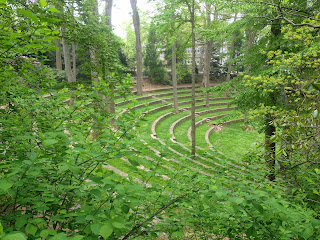It encompasses over 300 acres and contains over 4000 taxa and it aims to display ornamental trees, shrubs, vines and perennials suited for home gardens in this area.
With only half a day to explore this vast site we concentrated on the areas immediately surrounding the college’s beautiful buildings – some dating back to the 1800s, others built in recent years.
There were a series of themed courtyard gardens that provide the students and staff with a beautiful setting or backdrop for their work, as well as larger areas devoted to collections such as lilac, rose, and peony (where we were lucky enough to see a stunning and historic tree peony collection in full and magnificent flower).
Spread across the campus is a large collection of trees. Sometimes these are gathered in formal walks, or allees as they are called here including a very early planting of swamp white oak (Quercus bicolour) dating back to 1881 that stretched from the original campus building (Parish hall) to the local railway station; and a very fast growing avenue of Dawn Redwood (Metasequoia glyptostroboides) planted in 1997 but already towering four stories high.
Perhaps the visual highlight of the trip was the magnificent amphitheatre – one of the best and most effective examples of landscape design I have ever seen. It was designed by Thomas Sears and built in 1941. The site was a naturally occurring depression but was excavated and terraced in such a subtle way that it looked as though this area had been an ancient amphitheatre for hundreds of years that had been encroached by forest – rather than the other way around.
The arboretum also introduced us to more contemporary ecological and sustainable forms of horticulture including lawn substitutes using Carex species, Bioswales to manage storm water run off, and green roofs.
We had a fantastic tour and learnt an enormous amount in such a short time but the thing that will really stay with me is the numerous ways in which horticulture is introduced into the lives of the students ensuring that it will be of relevance to them in the future.
The students are of course surrounded by beautiful, well tended gardens full of interesting plants, but more than this they are involved in the garden: first year students are given a full tour of the grounds as part of their orientation and they are invited to plant a tree in the native woodland as part of an ongoing reforestation project. They are given an indoor plant to nurture throughout their studies. At graduation time, students are allowed to pick a rose from the Dean Bond Rose Garden to wear at their graduation ceremony that is held in the magnificent ampitheatre. Upon graduation they are also given Itea virginica ‘Henry’s Garnet’ (a cultivar of a native plant that Scott Arboretum was instrumental in getting into wider cultivation).
In other words horticulture is gently ingrained into the students lives and through this it will remain relevant and interesting to future generations – – a wonderful legacy of Arthur Hoyle Scott.
Robert Bradshaw, Swarthmore, Philadelphia, 09/05/2015


